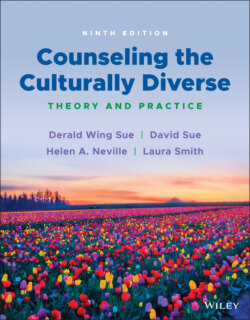Читать книгу Counseling the Culturally Diverse - Laura Smith L. - Страница 34
IMPLICATIONS FOR CLINICAL PRACTICE
Оглавление1 Listen and be open to stories of those most disempowered in U.S. society. Counseling has always been about listening to our clients. Do not allow your emotional reactions to negate their voices because you become defensive.
2 Know that although you were not born wanting to be racist, sexist, or heterosexist, or to be prejudiced against any other group, your cultural conditioning has imbued certain biases and prejudices in you. No person or group is free from inheriting the biases of U.S. society.
3 Understand and acknowledge your intense emotions and what they mean for you. CCD speaks about unfairness, racism, sexism, and prejudice, making some feel accused and blamed. The “isms” of our society are not pleasant topics, and we often feel unfairly accused.
4 It is important that helping professionals understand how they may still benefit from the past actions of their predecessors and continue to reap the benefits of the present social/educational arrangements.
5 Understand that multicultural training requires more than book learning. In your journey to developing cultural competence, it is necessary to supplement your intellectual development with experiential reality.
6 Do not be afraid to explore yourself as a racial, ethnic, and cultural being. An overwhelming number of mental health practitioners believe they are good, decent, and moral people. Because most of us would not intentionally discriminate, we often find great difficulty in realizing that our belief systems and actions may have oppressed others.
7 Open dialogue—to discuss and work through differences in thoughts, beliefs, and values—is crucial to becoming culturally competent. It is healthy when we are allowed to engage in free dialogue with one another. To a large extent, unspoken thoughts and feelings serve as barriers to open and honest dialogue about the pain of discrimination and how each and every one of us perpetuates bias through our silence or obliviousness.
8 Finally, continue to use these suggestions in reading throughout the text. What emotions or feelings are you experiencing? Where are they coming from? Are they blocking your understanding of the material? What do these reactions mean for you personally and as a helping professional?
Microtraining Series Video: Emotional Roadblocks to Counseling the Culturally Diverse
